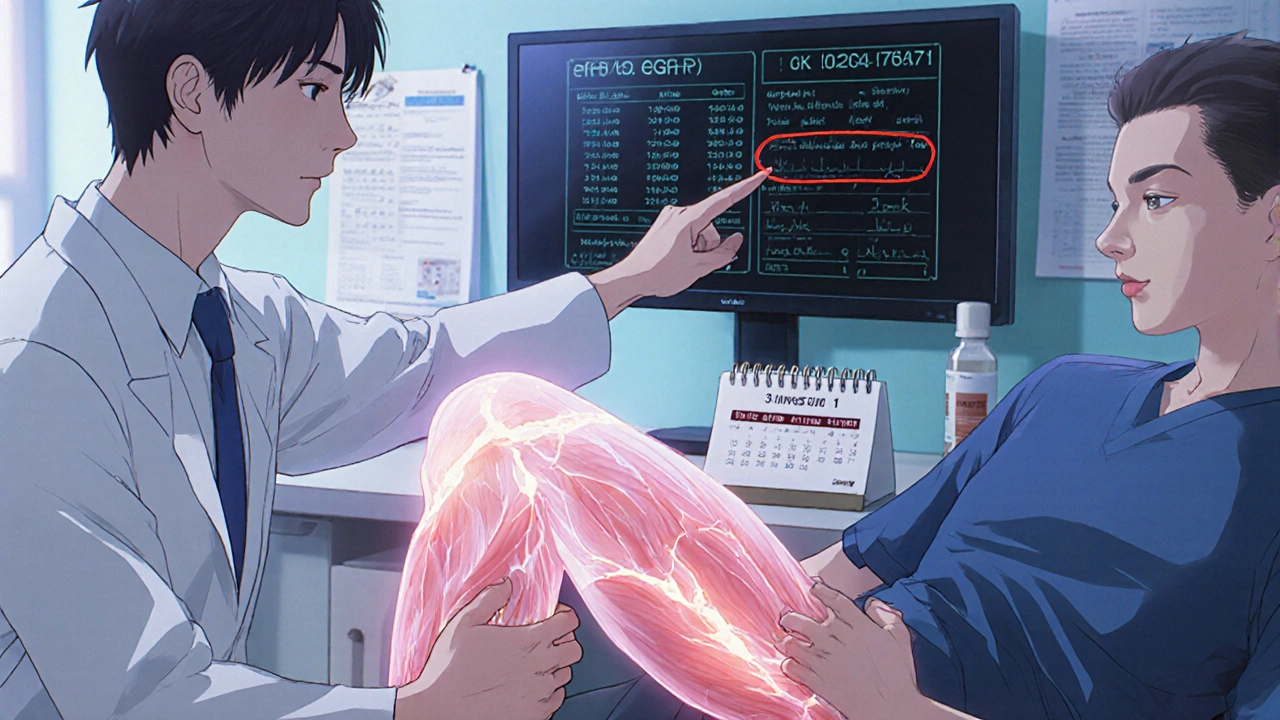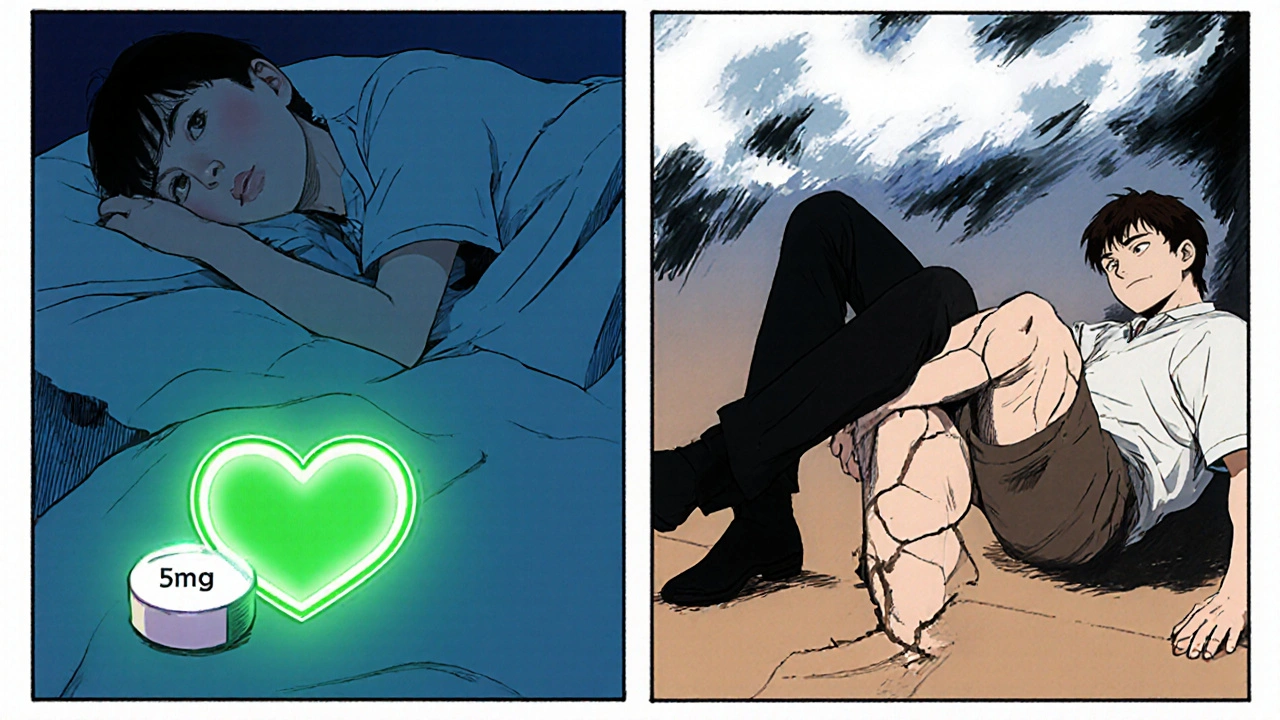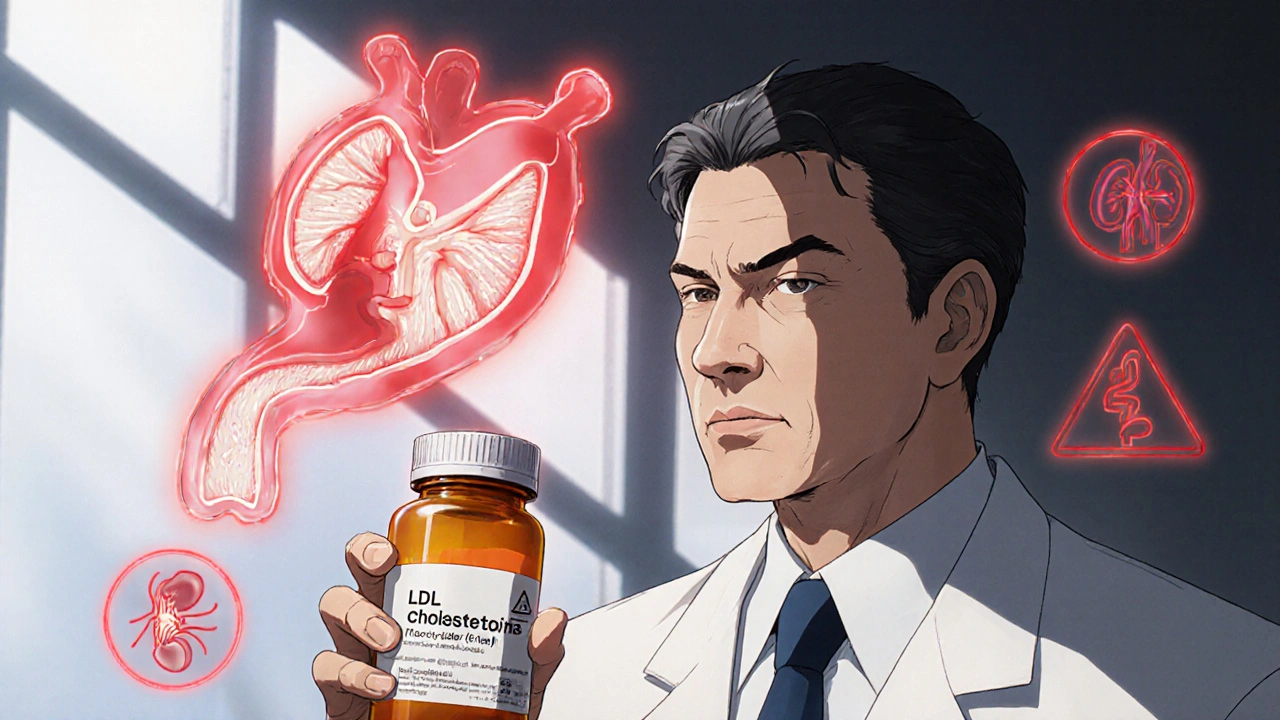Rosuvastatin Side Effect Checker
Symptom Checker
Check if your symptoms might be related to rosuvastatin and when to seek medical attention.
Important Note
This tool is for informational purposes only and does not replace medical advice. Always consult your doctor if you have concerns about side effects.
Rosuvastatin is one of the most powerful statins available today. If you’ve been prescribed this medication, you’re likely aiming for a big drop in LDL cholesterol - the kind that clogs arteries and raises heart attack risk. But with great power comes important responsibilities. Rosuvastatin isn’t just another pill. It demands careful monitoring, especially if you’re on higher doses or have kidney issues. Knowing what to watch for can mean the difference between staying healthy and ending up in the hospital.
Why Rosuvastatin Packs a Punch
Rosuvastatin works by blocking HMG-CoA reductase, the enzyme your liver uses to make cholesterol. But unlike older statins, it doesn’t just nudge LDL down - it slams the brakes. At 20 mg daily, rosuvastatin typically lowers LDL by about 55%. Compare that to atorvastatin 20 mg, which drops LDL by 39-41%, or simvastatin 40 mg, which only gets you to 25-35%. That’s why doctors reach for rosuvastatin when someone needs aggressive cholesterol control - like after a heart attack, or if they have diabetes and high triglycerides. Its potency isn’t just theoretical. The JUPITER trial, which followed nearly 18,000 people with normal LDL but high inflammation (elevated CRP), showed rosuvastatin cut heart attacks and strokes by 44%. That’s why it’s classified as a high-intensity statin at doses of 20 mg and 40 mg by the American College of Cardiology.What You Need to Monitor - And When
You don’t need blood tests every week. But skipping key checks can be dangerous. Here’s what your doctor should track, and when.- Before starting: Liver enzymes (ALT, AST), creatine kinase (CK), kidney function (eGFR), and HbA1c (to check for diabetes risk).
- 3 months after starting or increasing dose: Repeat liver enzymes and eGFR. This is when most side effects show up.
- Annually: If everything’s stable, check liver enzymes and eGFR once a year. No need to check CK unless you have symptoms.
Side Effects You Can’t Ignore
Most people tolerate rosuvastatin well. But some side effects are serious - and they’re often missed because they’re subtle.Muscle Pain and Weakness
This is the #1 reason people stop taking rosuvastatin. About 5-10% of users feel mild muscle aches. That’s normal. But if you’re having unexplained muscle pain, weakness, or cramps - especially in your thighs or shoulders - that’s a red flag. Add fever, dark urine, or extreme fatigue? That could mean rhabdomyolysis, a rare but life-threatening breakdown of muscle tissue. The risk is low - about 0.02% of users - but it climbs with higher doses and kidney problems. A 2022 survey of 450 U.S. physicians found that 74% of rosuvastatin discontinuations were due to muscle symptoms. If you notice this, don’t wait. Get a CK test. If it’s over 1,000 U/L, stop the drug immediately.Kidney Issues - Proteinuria
Rosuvastatin is cleared mostly through the kidneys. That’s good for avoiding drug interactions (unlike simvastatin, which is broken down by the liver), but it’s a problem if your kidneys are already weak. At 40 mg, rosuvastatin increases the risk of proteinuria - protein leaking into urine - by 2.3 times compared to 10 mg. This isn’t always dangerous, but it can signal early kidney damage. If your eGFR drops below 60 mL/min/1.73m², your dose should be capped at 10 mg. If it’s below 30, you shouldn’t take rosuvastatin at all.Diabetes Risk
Statins slightly raise blood sugar. Rosuvastatin increases fasting glucose by 5-10 mg/dL and HbA1c by 0.1-0.3%. That doesn’t mean you’ll get diabetes - but if you’re prediabetic, obese, or over 65, this matters. The FDA now requires statin labels to mention this risk. That’s why HbA1c is checked before you start. If your HbA1c was 5.7% before, and it’s 6.1% after six months, your doctor might switch you to a lower-intensity statin or adjust your diet.Cognitive Effects
Some people report brain fog, memory lapses, or trouble concentrating. The FDA has received reports, and studies show about 1-2% of users experience this. The good news? These symptoms usually disappear within 3 weeks of stopping the drug. If you notice this, talk to your doctor - don’t assume it’s just aging.
Who Should Avoid Rosuvastatin
Not everyone is a candidate. Rosuvastatin is contraindicated if:- Your eGFR is below 30 mL/min/1.73m² (severe kidney failure)
- You have active liver disease or unexplained persistent liver enzyme elevations
- You’re pregnant or breastfeeding
- You’re taking cyclosporine (used for transplants or autoimmune diseases)
Real People, Real Experiences
Look at user reviews on Drugs.com: rosuvastatin has a 5.8 out of 10 rating. Why? Because results are polarizing. One man on Reddit said: “My LDL dropped from 180 to 85 in three months. No side effects. Best decision I ever made.” Another wrote: “At 20 mg, I couldn’t walk without my legs aching. I stopped it. Within two weeks, the pain vanished. My LDL went back up - but I’d rather have high cholesterol than feel like I’m aging 20 years overnight.” These stories aren’t outliers. In a 2022 survey, 68% of physicians said patients had quit rosuvastatin due to side effects. But here’s the key: 74% of those cases were muscle-related, and nearly all happened at 20 mg or higher.
What to Do If You’re Worried
Don’t stop cold turkey. That can spike your cholesterol overnight and increase heart risk. Instead:- Keep a symptom journal: Note when muscle pain happens, how bad it is, and if it’s worse after exercise.
- Ask for a CK test if symptoms are new or worsening.
- Request an eGFR check if you’re over 60 or have high blood pressure.
- Discuss lowering your dose. Many people get the same LDL reduction on 10 mg as they did on 20 mg - with far fewer side effects.
Bottom Line
Rosuvastatin is powerful. It saves lives. But it’s not risk-free. The key isn’t avoiding it - it’s monitoring it right. If you’re on rosuvastatin:- Report muscle pain, dark urine, or extreme fatigue immediately.
- Get eGFR checked yearly - especially if you’re over 60.
- Don’t assume liver enzyme spikes mean you must quit. Wait for your doctor’s advice.
- Ask if you can drop to 10 mg. Many people do just fine.
Can rosuvastatin cause muscle damage even if CK levels are normal?
Yes. CK levels can be normal even if you’re experiencing muscle pain. The enzyme only rises significantly when muscle breakdown is severe - like in rhabdomyolysis. Many people report muscle aches or cramps without elevated CK. If symptoms are new, persistent, or interfere with daily life, talk to your doctor. They may lower your dose or switch you to a different statin, even if your CK is normal.
Is rosuvastatin safe for people with kidney disease?
It depends on how bad the kidney disease is. If your eGFR is below 30 mL/min/1.73m², rosuvastatin is not safe - it’s contraindicated. If your eGFR is between 30 and 59, you can take up to 10 mg daily, but 20 mg and 40 mg are not recommended. Always check your kidney function before starting and annually after. If your eGFR drops while on rosuvastatin, your doctor should reduce the dose or switch you to a statin cleared by the liver, like pravastatin or fluvastatin.
Does rosuvastatin interact with other medications?
Compared to other statins, rosuvastatin has very few drug interactions because only 10% of it is metabolized by liver enzymes. But it can interact with cyclosporine (used for transplants), gemfibrozil (a triglyceride-lowering drug), and some HIV medications. Always tell your doctor about every medication, supplement, or herb you take - even over-the-counter ones. Avoid grapefruit juice with any statin - it can increase levels of some statins, though the effect is smaller with rosuvastatin than with simvastatin or atorvastatin.
Can rosuvastatin cause diabetes?
Rosuvastatin can slightly raise blood sugar levels - enough to push someone with prediabetes into diabetes. Studies show it increases HbA1c by 0.1-0.3% and fasting glucose by 5-10 mg/dL on average. This doesn’t mean everyone will get diabetes, but if you’re overweight, over 60, or have a family history, your doctor should check your HbA1c before and after starting the drug. The cardiovascular benefits still outweigh the diabetes risk for most people - but it’s something to monitor.
How long does it take for rosuvastatin side effects to go away after stopping?
Most side effects improve within days to weeks after stopping. Muscle pain usually fades within 1-2 weeks. Cognitive symptoms like brain fog resolve in about 3 weeks on average. Liver enzyme elevations often return to normal within 4-6 weeks. If you stop because of side effects, your doctor may recommend a different statin or a lower dose. Never stop without talking to your provider - stopping suddenly can cause your cholesterol to rebound.
Is 5 mg of rosuvastatin effective?
Yes. A 5 mg dose lowers LDL by about 35-40%, which meets guidelines for moderate-intensity statin therapy. For many people - especially older adults, those with kidney issues, or those who had side effects at higher doses - 5 mg is enough. The goal isn’t to use the highest dose possible. It’s to get your LDL to target safely. Many patients achieve their LDL goal with 5-10 mg and avoid side effects entirely.
Next Steps
If you’re on rosuvastatin:- Write down any new muscle pain, fatigue, or changes in urination.
- Ask your doctor for your latest eGFR and HbA1c numbers.
- If you’ve been on 20 mg or 40 mg for over a year, ask if you can try 10 mg.
- Don’t skip your annual checkups - even if you feel fine.
- Ask: “Is this the right dose for my kidney function?”
- Ask: “Can we start low and go slow?”
- Ask: “What signs should I call you about?”


12 Responses
Been on 10mg for 2 years now. No muscle pain, no brain fog. Just feel like my heart’s not gonna bail on me tomorrow. 😊
lol statins are just big pharma’s way of making you pay for not being perfect. just eat less bacon and stop being lazy.
Let me be the first to say this: if you're getting muscle pain on rosuvastatin, you're probably also eating too many donuts and scrolling TikTok at 3am. The science is solid. The side effects? Mostly psychosomatic. Get a grip. And yes, I'm a doctor. 🩺
In India, many take statins without regular tests. I know a man who took 20mg for 5 years, never checked kidneys. Now he needs dialysis. This post is important. Not all bodies are the same. Listen to your body, not just the pill bottle.
It's fascinating how the general public conflates correlation with causation. The JUPITER trial demonstrated a statistically significant reduction in cardiovascular events, yet laypersons fixate on the 0.02% incidence of rhabdomyolysis. This is not medical advice; it is a statistical reality. Your anecdote does not override the meta-analysis.
I appreciate the thoroughness of this post. It’s rare to see such balanced information presented without fearmongering or corporate cheerleading. For anyone on rosuvastatin, I’d add: keep a journal. Track symptoms, mood, energy. It’s not just about labs - it’s about your lived experience.
My uncle dropped from 20mg to 5mg and his LDL stayed at 80. He went from limping to hiking mountains. Sometimes the magic number isn't the highest dose - it's the lowest one that still works. Also, grapefruit juice? Nah. I drink orange. Still alive. 🍊
I’ve been a nurse for 18 years and I’ve seen too many people stop statins cold turkey because they read a scary Reddit thread. If you’re worried, talk to your doc. Don’t just quit. Your LDL will spike, and that spike? It’s silent. It doesn’t hurt until it’s too late. And yes, 5mg works for a lot of folks. No shame in it. Your heart doesn’t care how big the pill is - it just wants you alive.
statins are just a scam to make you dependent on pills while they sell you more meds for the side effects. i got muscle cramps and they gave me a muscle relaxer. then i got acid reflux so they gave me prilosec. now im on 7 meds and still feel like death. who wins? not me
My doctor suggested rosuvastatin after my heart scan showed plaque. I asked if I could start at 5mg. She said yes. Two years later, my numbers are great and I haven’t missed a day of gardening. Sometimes, small steps are the safest path.
Let’s talk about the elephant in the room: statin-associated muscle symptoms (SAMS) are real, but they’re often misdiagnosed as aging or deconditioning. I’ve seen patients who thought their fatigue was just ‘getting older’ - until they stopped the statin and had a second wind. It’s not just CK levels - it’s quality of life. And if you’re prediabetic? Don’t panic. HbA1c +0.3% doesn’t mean you’re doomed. It means you need to move more, eat cleaner, and maybe drop to 10mg. The goal isn’t perfect labs - it’s sustainable health.
They told me rosuvastatin was safe. Then my kidneys started failing. They said it was 'rare.' But 74% of docs say patients quit because of muscle pain - so why isn't this on the warning label? And why is the FDA still letting them sell this? I think this is all part of the pharmaceutical-industrial complex. They don't care if you live or die - they care if you keep buying pills. And now I'm stuck on dialysis because I trusted the system. Wake up.